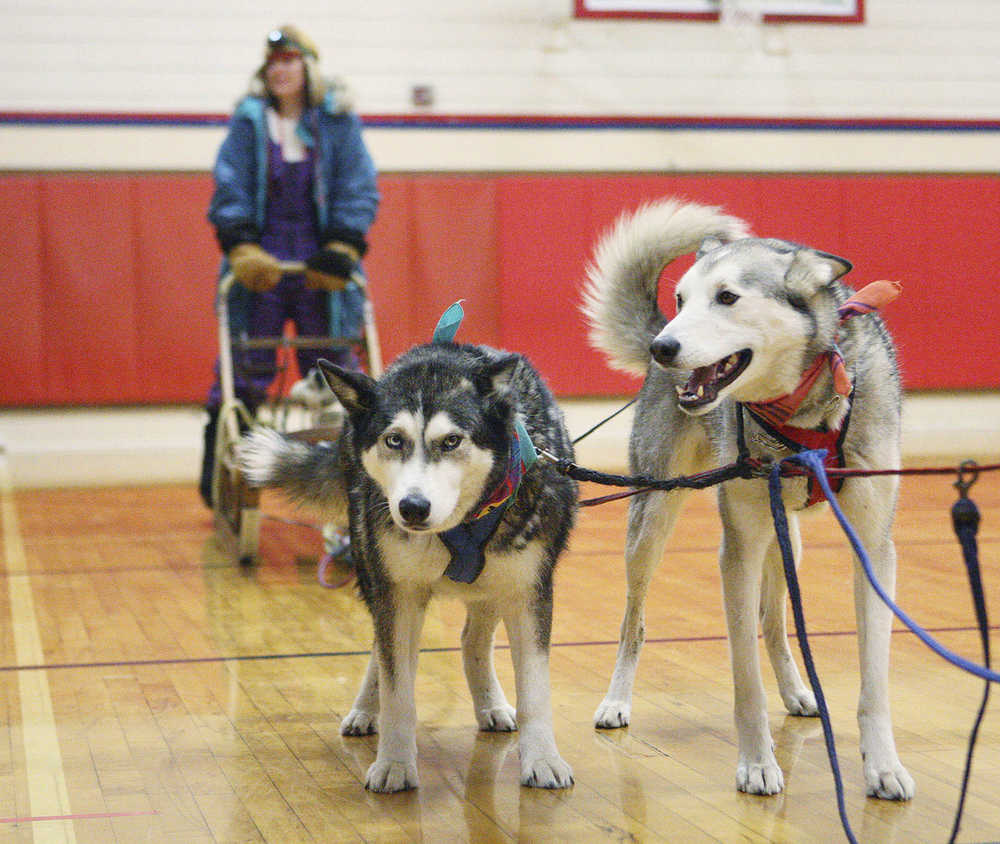AMITY, Ore. — Lorraine Temple pulled her van into the parking lot at Amity Middle School in Oregon. The Homer resident was greeted by Principal Dave Lund.
A dog sled was affixed to the top of the van. Two Alaskan huskies, 4-year-old Willow and 10-year-old Cabo, were riding in the cargo area. Willow’s head was poking out a side window.
Staff and students were treated to an entertaining 1 ½-hour presentation by Temple. She described the interesting life she’s lived, educated her audience on the Iditarod dog sled race from Anchorage to Nome, and most importantly, emphasized to each student the importance of following their life path, regardless of where it leads them.
“It’s about the spirit of your own unique life,” Temple said. Later, she told the students, “You never know what’s going to happen. It’s a big, exciting world out there.”
Temple reminded all the students that they possess their own ideas, that every one of them is creative in their own and personal way.
“One thing I’ve enjoyed most is being a dog musher,” said Temple, who holds a bachelor’s degree in environmental studies from the University of California at Santa Barbara, which did not prepare her in the least for positioning herself on the back of a sled.
“You can imagine what my parents thought of that,” Temple said. “I realized what I enjoyed doing.
“Listen to your heart. Give it your all and don’t go halfway.”
Temple was still addressing the school’s staff and students in the gymnasium when Cabo and Willow could be heard barking and yelping from inside the van.
“I hear our little buddies out there,” she said.
Lund and teacher Mary Motocha were summoned. “Handlers,” Temple called out.
Motocha, who was seated in the bleachers, and Lund, who was standing nearby, went to the van to retrieve Cabo and Willow, whom Temple fondly refers to as her family.
Before the all-school assembly ended, Temple had demonstrated how the dogs are harnessed to the sled, and she outfitted teacher Mindy Wallace in the clothing worn by Iditarod racers. While she has trained dogs for the race, she has never participated.
“One nice thing about those boots is, you don’t have to wear socks,” Temple told Wallace.
One of the gloves had a patch on the front. Temple asked the students what purpose that served.
One student said he thought a dog had chewed through the glove. Not at all.
Iditarod racers face extremely harsh weather conditions, as the race ends in Nome, located on the coastal waters of the Bering Sea. Mushers use the patch to wipe their nose whenever that becomes necessary.
Temple said “the most important thing is that beaver hat,” which Wallace wore under a furry hood that covered her head to such an extreme you could barely see her face.
Temple showed a variety of mushing-related slides, in addition to a video. On a wall in the gym, she displayed an Alaska map with the race course outlined. Another map compared the size of Alaska to the Lower 48. Portland, Oregon, isn’t much bigger, population-wise, than the entire state.
She asked the students if they knew the state’s capital city. A boy yelled out, “Juneau,” the correct answer.
Temple explained that Iditarod means faraway or distant place. She explained that mushing is the state sport of Alaska.
Amity’s sixth graders have integrated a reading exercise into their study of the Iditarod race in recent years. Temple told the students that reading is an amazing way to discover the world.
Just like the race, which started Saturday, March 5, there are checkpoints throughout the school, and a staff member represents each checkpoint. A student receives credit for reaching a checkpoint by reading a specific number of pages.
The checkpoints are as follows:
No. 1. 100 pages; No. 2. 250 pages; No. 3. 500 pages; No. 4. 750 pages; No. 5. 950 pages, and No. 6. 1,049 pages, which signifies the end of the 1,049-mile race.
Prizes are awarded to students passing each checkpoint. For students reading 1,049 or more pages, pizza and ice cream floats await them at the Finishers’ Banquet.
“Every year, for as long as I can remember, we’ve done a reading competition for the students that coincides with the race,” said Wallace, who has spearheaded the exercise. “The end goal is 1,049 pages.”
Although the race, commonly referred to as the “Last Great Race,” is officially 1,049 miles, since Alaska is the 49th state in the union, the race is actually more than 1,150 miles long.
Wallace added, “Kids are expected to read outside the classroom. This gets them excited about reading. You can learn so much through reading.”
During the 2015 race, students read more than 65,000 pages, Wallace said, with 21 reaching the 1,049-page mark.
The Amity Education Foundation has helped fund the project over the years.
It was Temple’s first visit to Amity, and Lund said he was impressed with her presentation. He said she did a good job of holding student attention.
Temple takes her dogs to schools during the first four months of each year. She’s been doing it for 20 years.
During the rest of the year, she works as an independent contractor at the Kenai Princess Lodge in Cooper Landing. She leads tours around the town, which is located on the Kenai River.

